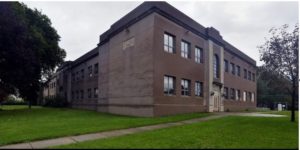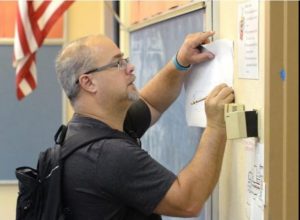CJL Engineering in the News!
Erie School District Renovation Plan Starts at $60 Million

Burton Elementary

CJL’s Tom Kapcsos makes notes
The district wants to borrow at least that much to fix structural problems that had gone unaddressed because of its financial crisis.
The Erie School District is preparing to renovate its schools with a plan that is likely to involve at least $60 million spread across many of its 16 school buildings over three years.
Just don’t expect the overhaul, all but certain to be funded through a bond issue and possibly a tax increase, to result in the construction of gleaming, new institutions of learning.
While wide-ranging, the plan comes down to three words: “warm, safe and dry,” as Superintendent Brian Polito said.
The plan will focus on such basic but critical areas as fixing leaky roofs, upgrading existing heating and air-conditioning systems, repaving parking lots, sealing and re-pointing facades and increasing safety measures. The Erie School District has put off those types of projects for years because of lack of money.
Most of the fixes, Polito said, “will be behind the walls, that the public will not see. But many of the things we have not addressed in years, or not at all, so they are a high priority.”
The 11,500-student district over the past year has raised the possibility of undertaking a building overhaul to coincide with its new five-year strategic plan, which the School Board approved in June and which concentrates on academic advancement.
Polito’s administration is in the final weeks of developing a building proposal for the School Board to consider in late October or early November. The proposed project, Polito said, will likely be divided into two phases: $60 million over three years and, if necessary, another $60 million after that.
The district’s architects on the project, with HHSDR, of Sharon, have been visiting each of the district’s buildings to examine the needs. The review has included the district’s 16 school buildings that are in use — 10 elementary schools, three middle schools, two high schools and a school for the district’s alternative education programs.
But the district is also reviewing the needs of its buildings that are no longer in use and that are for sale. They include the former Wayne, Irving and Burton schools. Roosevelt Middle School is also vacant, though it is so dilapidated that the district has said demolition is likely the most viable option.
The building plan also might include limited repairs to Veterans Stadium, including fixing leaks to the press box roof and water damage in the area of the south bleachers, said Eric Seibert, the Erie School District’s director of facilities and maintenance.
The vacant schools are part of the building plan in case the district determines it must use them in the years ahead, possibly as places to put students when other schools are under or repair or possibly as places to move students if other schools prove too expensive to fix.
“This building’s being considered for future use,” Seibert said Tuesday while on the roof during a tour of the former Burton Elementary School, 1660 Buffalo Road, which the district closed in 2012 because of declining enrollment.
“It’s being evaluated by architects and engineers to determine what, if anything, would need to be done for reopening this school if the district would decide that is something that would be favorable to us,” Seibert said.
“A lot of stuff just needs to be updated, just to bring to life, because they have not been used for so long,” Kapscos said.
A different plan
The Erie School District recently had bigger building plans.
In April 2017, as the district struggled through its financial crisis and waited on state help, Polito and his predecessor as superintendent, Jay Badams, pondered the possibility of expanding specialized magnet-school programs at the newly-created Erie High School by erecting an addition to the 500,000-square-foot building at a cost of as much as $49 million.
The addition to Erie High, which was built in the 1950s, would have been part of a districtwide building project that would have cost as much as $67 million.
The $14 million provided the district with enough financial security to allow it to undertake a modest building program, Polito said. Instead of leveraging some of the additional funding into one large project, the district determined the money would be better spent by fixing the existing buildings, Polito said.
By spending so much on one project, the district would not “be able to address the pressing needs at the other buildings,” Polito said.
He also said the district wants to be able to set aside another portion of the $14 million to pay for education-based initiatives, including updated curriculum in core subjects, such as reading and math, as well as the hiring of behavioral interventionists at many of the schools.
The district must also come up with a building plan in the context of the financial improvement plan that a state-appointed financial administrator, Charles Zogby, is continuing to develop. The General Assembly required the appointment of the administrator in conjunction with the Erie School District receiving the additional $14 million in state aid.
“We just can’t take a look at this in a vacuum,” Polito said of the building overhaul.
Paying for the project
The district’s debt service and related expenses are below the average for the state’s 500 school districts, according to a district analysis.
To borrow the $60 million for the building project, Polito said, the district would extend its debt payments by about another 15 years, and “wrap” the new debt payments around the current payments, similar to when a homeowner extends a mortgage.
The district could finance the entire additional bond debt — in an initial amount of $60 million — by extending the debt. But Polito, a certified public accountant and the Erie School District’s former chief financial officer, said the district would save a total of $12 million in debt service payments over 15 years if the district used about $3 million of its own funds a year to make additional bond payments over the longer period of borrowing.
Once the district spends the $60 million, Polito said, the administration and the School Board could explore whether the district needs to borrow another $60 to make more repairs.
The initial $60 million, Seibert said, will be “applied to our most troubling issues.”
As for a tax increase, Polito said his administration and the board will have to determine whether the district needs to raise taxes to keep the district’s budget balanced as it spends more on building projects and education initiatives, such as the upgraded curriculum.
And under the state formula that caps the amount of a school district’s possible tax increase, the Erie School District currently can raise property taxes by no more than 3.7 percent, a figure that is expected to remain steady in the years ahead. The district’s current budget includes a tax increase of 0.5 percent, which raised taxes by about $8 a year for the owner of a house assessed at $100,000.
Polito, who started as superintendent in July 2017, said he wants the School Board to consider smaller tax increases from year to year to keep the district solvent as it manages its debt payments and other costs. He said he wants to avoid situations in which his administration “is kicking the can down the road and limiting future administrations’ ability to balance the budget.”
His goal, Polito said, is for the district to spend as much as it can on capital projects and educational programs while maintaining the financial stability that has come with the increased state funding. The building program, Polito predicted, will not be flashy, but will leave the district with something it needs: “Warm, safe and dry buildings.”
Ed Palattella can be reached at 870-1813 or by email. Follow him on Twitter at twitter.com/ETNpalattella.
